Anatomy of trigger mailings. The whole tool in 10 minutes
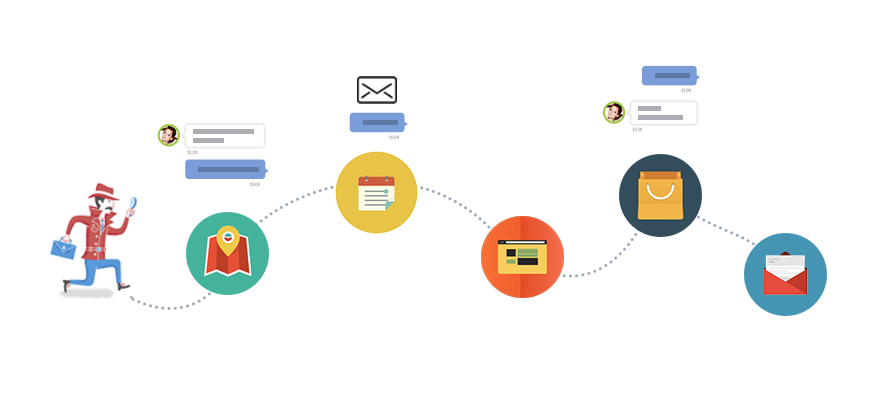
Are you good at trigger mailing? The focus of Internet marketing is shifting rapidly from attracting a mass of new visitors to personal work with each attracted.
What is the point of attracting many visitors if most of them go away in a few minutes, and only 1-2% reach the purchase? First, you need to establish retention, persuasion and return, and only then build up traffic. Successful projects build their economy on this. The main tool that will help automate this process is trigger mailings.
We (the Carrot Quest service team ) made a kind of trigger email marketing methodology to make it easier for you to navigate and apply in your business.
Trigger mailings are a trigger mechanism, which is enough to configure once, after which he will run all the letters directly to the target.
A trigger email will only be sent if it is relevant to the user. This is the exact opposite of mass manual mailings, where one message (letter) is sent to everyone, regardless of the user's life cycle, the context of use of your site and the segment that the user is a member of. Personalization and relevance in the letter can be achieved through knowledge of user actions on the site.

- went to the site
- pressed the button
- left an email,
- from which channel came
- registered
- used the new feature,
- looked through the product page, etc.
By these actions, you can determine at what stage the purchase is a visitor and due to what it can be converted into a customer, hold or make a re-sale.
There are many options and scenarios for effective trigger email marketing. It is not always clear which mailings should be used and for what purposes. Therefore, we decided to put everything on the shelves. We will analyze each option in detail:
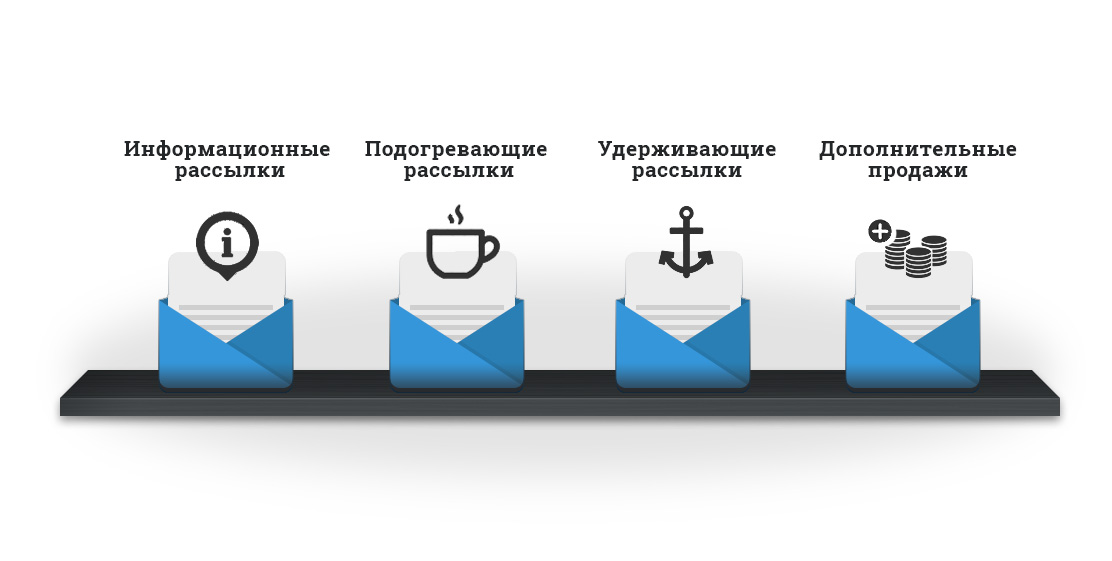
1. Newsletters
These are the simplest and most popular trigger mailings. They are sent when we report the status of the user. In such letters there is no task to make a sale, return the user or explain to him the capabilities of the product.
For example, the user has registered - a letter is sent to him with pleasant words of thanks.
Here are some more examples of such letters :
- User made a purchase . Your actions: in a letter, say thank you for the purchase, note the good taste of the client and give advice on the operation of the goods;
- A discount. You gave the client a personal discount and it comes to an end - a letter reminding you that the discount will end in N-days (there may be several letters, for example, the first: “4 days left until the discount ends”, the second: “1 day left, hurry up ... ");
- The client uses your service in the trial period - to remind you how many days are left until the end of the free subscription and the need to pay (here, too, there may be a chain of several letters);
- The client paid for a service , for example, a tourist ticket to France - a few days before the trip to remind him of this and give a list of things that he might need in France.
A detailed example
Here is an example of a chain of newsletters that we do in our own service. Carrot quest is a service that combines e-CRM, online chat, email newsletters (trigger and manual), pop-ups and analytics. We give the user 14 days of a trial period. During this period, 4 information letters are automatically sent to him.
a) "Thank you for registering . " We tell you what you need to do to start using the service. We explain how to put the code on your site. We give instructions. b) "It took 7 days of the trial . " 7 days after the start of the trial period, a letter is sent with information that only a few days of free work remain. We ask if everything is clear to the user and gives a list of additional instructions.
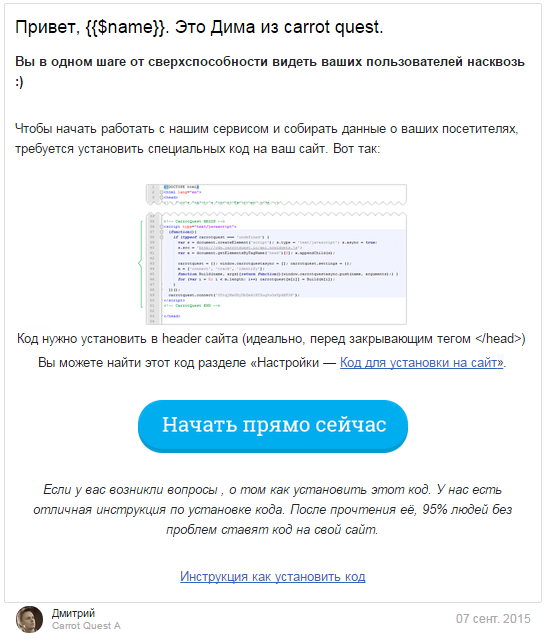
c) “12 days of the trial have passed . ” Thank you for using the service. We remind you that only 2 days are left. We show a table with our tariffs, from where the user can immediately proceed to payment.
d) "The last day of the trial . " We warn you that tomorrow the service will be disconnected, that payment must be made in order to continue using the Carrot quest tools.
Plus, every day we send letters with statistics: what a user received in our service in 1 day by connecting his site.
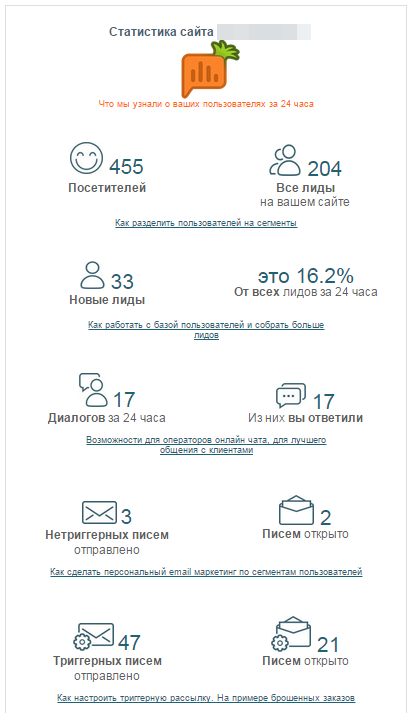
2. Activation (warming up) mailings
We noticed that the popularity of such trigger letters is growing. Rather, this is due to the fact that marketers began to understand the value of content and user activation in the product.
To turn your user into a regular customer or an evangelist (who advises your product to his friends), you need to show the full value of your product and the benefits that it will receive from it.
This can be done using trigger emails. As soon as the user has begun to be active in your product or service (registered, several times viewed the same product, left a request, etc.), you send him a letter describing the functions and capabilities of your product: how to use it and what to use Attention.
Examples of such letters:
- Activation. After the client began to use the service (for example, SaaS service) - send a chain of trigger letters. In each of the letters talk about a separate function and features of your product; In Carrot quest, we send 9 lessons to tell the user step by step about the value of the product. So he will find ways to work convenient for himself and learned how to manage the service.
- Lead heating. Often visitors look at the same products, but never buy. At these stages, you need to warm them up with the help of useful content, otherwise they can leave and buy from competitors.
Imagine you are selling GoPro Hero 4 cameras. There is a whole segment of users who come in and view this camera for the third time, but never buy it. Set up trigger letters for this segment in which you will describe the camera, its advantages, differences from similar products, etc. You can show the top best videos shot with GoPro and much more. The only caveat is that you must receive emails from such users in order to send letters, as When viewing products, users rarely leave their contacts. The best solution in this case is to show a small pop-up, and already in it offer to leave the email in exchange for useful materials (a little more details about this).
Such letters fuel the interest of the user and help him make a choice in favor of you, not your competitors.
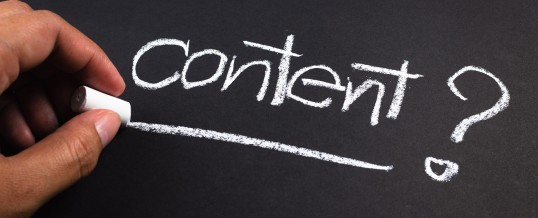
It is very important that your content is truly useful. The more accurately you define the portrait of the user and his tasks, the more relevant content you offer him. So, attract his interest and be able to bring it to sale.
A detailed example
In the article “ how a web studio in 4 steps increased the number of applications by 2.5 times and increased the average check ”, we gave an example of how trigger mailings are used at one of the stages of working with potential customers.
First of all, site visitors were divided into segments (this was achieved by tracking the actions of each user). For users from the “online shopping” segment, a pop-up window was sent to the trigger with a request to stop the email, in return for 3 useful articles.
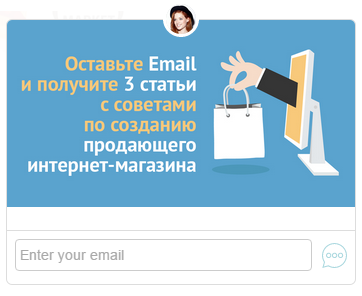
After the user left an email, a trigger chain of 3 letters was launched. The purpose of each letter is to foster user interest, show the expert status of the company and encourage the user to purchase.
1st letter: “25 errors when creating an online store” (will be sent 1 day after the action);
2nd: “An article-case about abandoned baskets” (after 3 days);
3rd: “How usability and design affect sales in the online store” (after 7 days). The number of such letters for each case and a specific area will differ, so you should experiment. All the best newsletters do not contain any advertising, give the reader a favor and he will come to you.

3. Trigger letters to hold and return
The main tool to retain and return users is just trigger emails. Imagine a user visited a site, was interested in a product or service, but for some reason left. As a rule, 55-80% goes away.
This problem is solvable because with the help of Carrot quest we already know what is interesting for each user and can return them. Such a large number of users cannot be returned manually, so automation is very welcome here.
Here are examples of such letters:
- If a user bought a product with a short life cycle , at the end of this cycle, remind him that the time has come for a new purchase (we will consider in more detail below);
- Abandoned basket - when a visitor viewed a product, added it to the basket, but never bought it. A letter is sent with information about the product and an offer to complete the order, sometimes already at a discount;
- Left order - by order here we mean your main target action (what it will be: buying a product, registering, paying for a service, filling out an application, etc., is up to you). If the user started this action, but did not finish it, return it with a trigger letter and give an occasion to complete the order.
- Viewed products (pages) - if the user has viewed the same product several times (or a page with a description of the service), it means that he has great interest. It is better to send such a user a letter with a discount on this product (service) than to wait until he leaves for competitors.
- Return of inactive users. Set up trigger mailing for a segment of users who used to buy from you and are now completely inactive or do not visit you. Offer them discounts, special conditions or expert help.
Detailed example
Let's take a closer look at the product life cycle example. When we sell a product or service that users will never stop buying (clothes, medicines, equipment, hairdresser services, try to travel every vacation, etc.)
Imagine you are selling men's t-shirts on the Internet. Your data shows that 10% of users return after 6 months and buy new t-shirts. It is likely that the product life cycle is 6 months.
“5.5 months have passed.” A trigger letter will be sent out 5.5 months after purchasing the T-shirt. In it, we recall that the last time a customer bought a T-shirt from us (because during this time he could have forgotten). We say that the user has a great taste and ask if he is satisfied with the last purchase? After that, we remind you that you have new wonderful t-shirts and offer to look at them. With such a simple scenario, these 10% of repeat purchases will increase to a minimum of 25-30%. A frequently asked question is what to do when the user has not left an email, on this subject we wrote the article “The user did not leave an email? 9 examples of how to keep it and bring it to a purchase ”
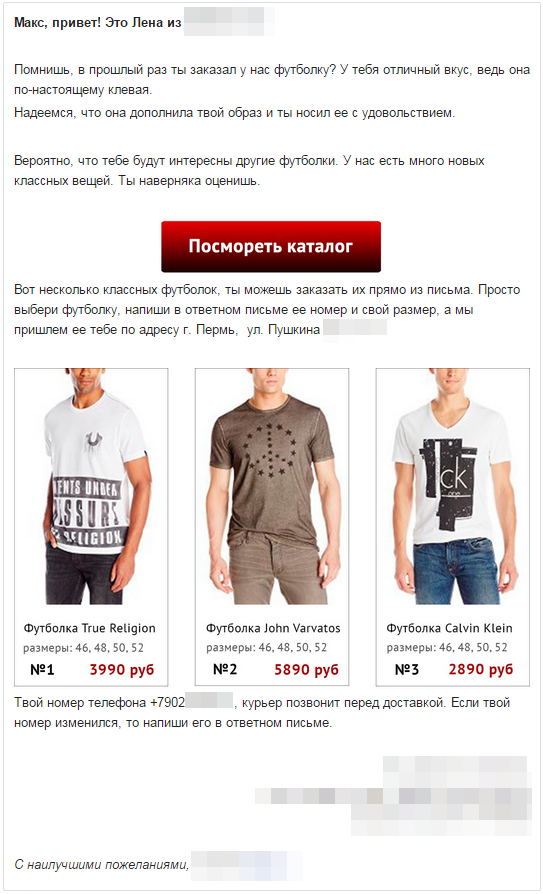
4. Trigger letters for additional sales (cross-sell)
Do you have something that you can sell in addition to an already purchased product or service? Then the trigger letters will do it most effectively.
The problem is that companies offer additional products (which are relevant when purchasing the main product) only at the time the customer makes the purchase. At this moment, the client may not have extra money to please himself, and he will leave without buying. According to statistics, only about 20% are immediately bought, where are the remaining 80%?
Some time after the purchase, it is worth sending the client letters with offers that are relevant to him. Sending time already depends on the specifics of your market and product features. It takes several minutes to set up.
Here are examples of such scenarios:
- A client bought a camera , but did not buy additional products, such as a memory card, case, bag, portrait lens, tripod, etc. It is likely that he will not need some of this right away, so offer him such products after a while. But do not forget to offer them at the time of purchase;

- Ordered a book - run trigger letters that will be sent when you purchase one of the most popular books. In these letters, talk about books in similar subjects and offer to buy them;
- I attended the training - in order to sell additional trainings, lessons, books, presentations, configure the chain of trigger letters in which you will talk about additional goods and services.
- Bonuses for activity - if the user has been active recently (bought several times, often visited the site, left his reviews), then you can automatically give such a segment a bonus. The bonus will push such users to an additional purchase.
A detailed example
Let's analyze the trigger letters for add. sales in the tourism sector. There are a lot of additional sales in tourism: insurance, car rental, excursions, airport transfers, foreign SIM cards, travel guides, translators, etc. If some of them are bought at the same time as a ticket, then customers can feel the need for the rest just before the trip .
You can run a chain of trigger letters that will be automatically sent a few days after buying a ticket. In letters to offer to buy these goods or services before the trip.
For example, 3 letters.
First: description of excursions with prices and offer to pay.
Second: the offer to purchase guides and use the services of an interpreter.
Third: to offer a transfer - to bring and pick up from the airport. It is worth experimenting with such newsletters, selecting the optimal time for you and the message for the client. An important stage: to analyze the reaction of users, how the letter influenced his further actions.
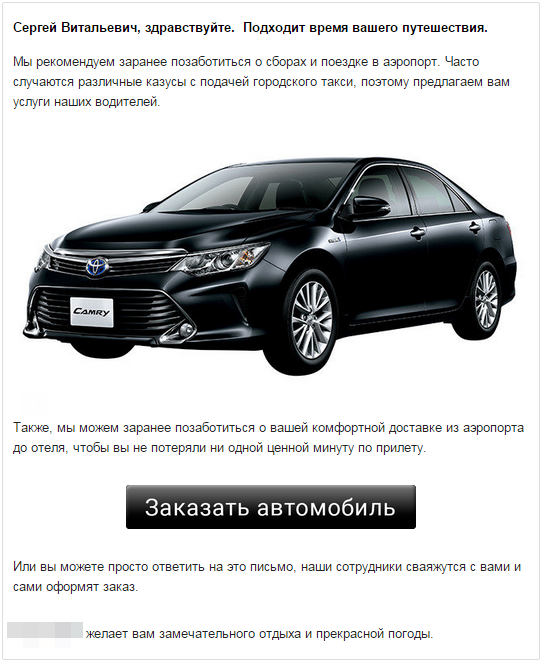
PS
We tried to classify mailings by purpose and type of use in order to simplify the task of using trigger mailings. In reality, it happens that in one mailing these goals and types are combined and intersected. To avoid confusion, clearly separate the newsletters by type and set goals for each campaign in advance.
With pleasure, the team of Carrot Quest - a service for the automation of Internet marketing .
